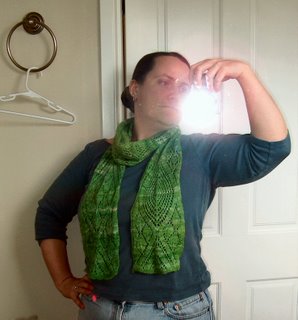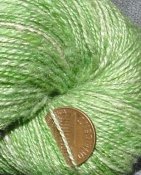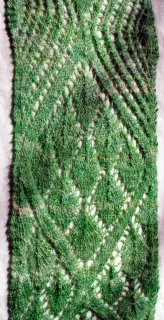Creme de Menthe Sampler Scarf

Creme de Menthe Sampler Scarf
This, too, was a blending experiment, but one gone mostly right. It only went wrong a tiny bit, in that when all was said and done and I had loaded my then-new Strauch 405 "Finest" drum carder with all the cashmere, merino, and tussah silk that I'd dyed in that particular small batch, it turned out to be about two thirds as much fiber as I needed for a full batt. It would easily have been a full batt on the Ashford fine drum carder I had been borrowing, but the Strauch wanted more.
The only other thing I had handy which I could even consider putting in with cashmere and tussah silk, though, was merino -- and I only had white merino. So "What the hell," says I, and in it went. I decided to put it through only one more pass and leave in some streaky white bits, rather than blending it further and lightening the green overall. The green was already very bright and the last thing I could have countenanced would have been it turning pastel.
 The Strauch fine carders, with the brush, just do an incredible job on blending things like that. I've since done lots and lots of merino/tussah/cashmere blends, and they're so much fun to spin! One interesting thing that this particular yarn really helps me to illustrate is the point I'm forever harping on, that yarn should be designed to have the qualities one wants in the finished product, rather than in the skein or on the bobbin or spindle -- and by "finished product," I mean it's been washed, blocked, and maybe even is actually in use.
The Strauch fine carders, with the brush, just do an incredible job on blending things like that. I've since done lots and lots of merino/tussah/cashmere blends, and they're so much fun to spin! One interesting thing that this particular yarn really helps me to illustrate is the point I'm forever harping on, that yarn should be designed to have the qualities one wants in the finished product, rather than in the skein or on the bobbin or spindle -- and by "finished product," I mean it's been washed, blocked, and maybe even is actually in use.When I would hand people this skein of yarn -- even sometimes to seasoned knitters -- they'd look at it briefly, and feel it, and say "Hrmmm, that's thin," and that would be that. The skein of yarn just never got the reaction I thought it should, from specific people who I thought for sure would just adore the yarn. I found this puzzling until I realized that most people are actually shopping for yarn that's already acting like you'd want the finished product to act, before you've made it. This didn't dawn on me until I realized that the people who did have a clear picture of the yarn's properties were all weavers with a lot of experience in handling lots of kinds of yarn, and who are used to thinking about a finished product differently from how today's knitters and crocheters commonly do, and who are accustomed to seeing what they're working with change while being worked.
 This yarn has significantly more twist in it than is typical for commercial yarns in this thickness (I knit the scarf on US size 2 needles, which were the biggest I could get away with). In the skein, though it had been washed and hung unweighted to dry, it had a stiffer hand than most lace knitting yarns, and was very smooth-surfaced with essentially no fuzz.
This yarn has significantly more twist in it than is typical for commercial yarns in this thickness (I knit the scarf on US size 2 needles, which were the biggest I could get away with). In the skein, though it had been washed and hung unweighted to dry, it had a stiffer hand than most lace knitting yarns, and was very smooth-surfaced with essentially no fuzz.However, once the scarf was complete, and I washed it and gave it a half-assed blocking and a little light steaming with an iron, the scarf became an airy, fuzzy, sinfully soft object which, when I wear it, people cannot stop commenting on. The same people who looked at, and even handled the yarn, only to shrug and say "Seems like thin yarn," had totally changed their tune!
So here's the thing: not only does this scarf have that sort of feel to it, but it's going to keep having that feel forever. It'll stand up to real world wear, to repeated washing, and it'll always be a 45-gram slice of luxurious warmth! On the other hand, a comparable millspun yarn -- assuming you could find one -- will typically have a lot less twist, and just won't wear as well. It takes experience and practice to get a feel for it, I suppose, but I always strive to teach people to look not at the yarn as it is when you pick it up, but what it'll be like once you make it into something -- and of course, if it can stand up to the process of being used. If you're knitting or crocheting, it's not as tricky -- those aren't methods of yarn use that are usually hard on yarn. But at the same time, it's not uncommon for me to hear from knitters and crocheters who expected something really different from a given yarn, and who find the finished object unsatisfying.
This scarf is long, and if you're interested in it, you'll definitely want to click on the link at the top and go check out the photo gallery (comments welcome there as well).


3 Comments:
Abby, thanks for the information!
Ed used to talk a lot about you and your sister - we got to know him at SOAR, visited him in Ithaca once, and he stayed with us here in Yorkshire a couple of times. We, like most people, felt it was a privelege to have known him.
Oh - nice scarf, by the way. Now, why does that design look familiar.....
Carol
The one major hole I've discovered in the teaching of spinning and using handspun yarns is how much they change in character once washed. I still haven't a clue how much anything will bloom once plied and wound off. It adds a certain mystery to the process but hard to spin for a particular project if you think you are spinning sport-weight and it blooms to heavy worsted.
Thanks for your comment Abby!
Your own projects are gorgeous
:)
Manasi
Post a Comment
<< Home